Related Research Articles
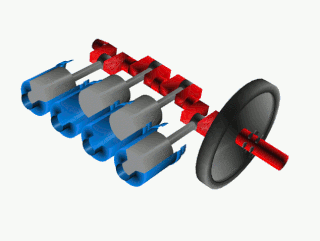
A crankshaft is a shaft driven by a crank mechanism, consisting of a series of cranks and crankpins to which the connecting rods of an engine is attached. It is a mechanical part able to perform a conversion between reciprocating motion and rotational motion. In a reciprocating engine, it translates reciprocating motion of the piston into rotational motion, whereas in a reciprocating compressor, it converts the rotational motion into reciprocating motion. In order to do the conversion between two motions, the crankshaft has "crank throws" or "crankpins", additional bearing surfaces whose axis is offset from that of the crank, to which the "big ends" of the connecting rods from each cylinder attach.
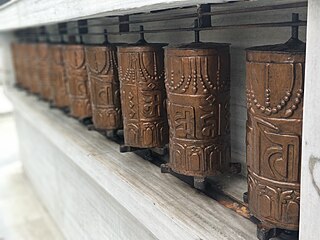
A prayer wheel is a cylindrical wheel on a spindle made from metal, wood, stone, leather or coarse cotton.

A hubcap is a decorative disk on an automobile wheel that covers at minimum the central portion of the wheel, called the hub. An automobile hubcap is used to cover the wheel hub and the wheel fasteners to reduce the accumulation of dirt and moisture. It also has the function of decorating the car.

A stunt performer, often referred to as a stuntman or stuntwoman, is a trained professional who performs daring acts, often as a career. Stunt performers usually appear in films or on television, as opposed to a daredevil, who performs for a live audience. When they take the place of another actor, they are known as stunt doubles.

Knife throwing is an art, sport, combat skill, or variously an entertainment technique, involving an artist skilled in the art of throwing knives, the weapons thrown, and a target. In some stage performances, the knife thrower ties an assistant to the target, and throws to miss them.

A bench grinder is a benchtop type of grinding machine used to drive abrasive wheels. A pedestal grinder is a similar or larger version of grinder that is mounted on a pedestal, which may be bolted to the floor or may sit on rubber feet. These types of grinders are commonly used to hand grind various cutting tools and perform other rough grinding.

A burnout is the practice of keeping a vehicle stationary and spinning its wheels, the resultant friction causing the tires to heat up and smoke.

Fiendish Freddy's Big Top O'Fun is a video game developed by Gray Matter under developer Chris Gray and published in 1990 by Mindscape. It originally appeared on the 16-bit Atari ST, IBM PC and Commodore Amiga, before later being converted to the ZX Spectrum, Commodore 64, Amstrad CPC. The Commodore 64 version was included on cartridge bundled with the Commodore 64 Games System.
A centreless wheel is a wheel where the axle is hollow and follows the wheel at very close tolerances.
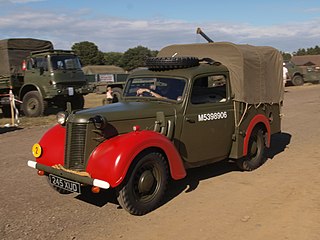
Fender is the American English term for the part of an automobile, motorcycle or other vehicle body that frames a wheel well. Its primary purpose is to prevent sand, mud, rocks, liquids, and other road spray from being thrown into the air by the rotating tire. Fenders are typically rigid and can be damaged by contact with the road surface.
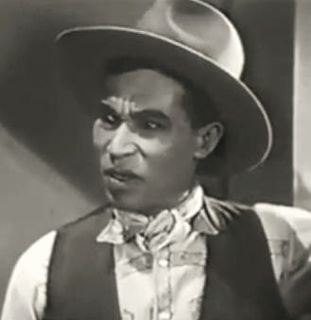
Steve Clemente was a Mexican-born American actor known for his many villainous roles. He began acting in his teens, signing up for his first movie, The Secret Man, in 1917. His later roles were usually bit parts.

Impalement arts are a type of performing art in which a performer plays the role of human target for a fellow performer who demonstrates accuracy skills in disciplines such as knife throwing and archery. Impalement is actually what the performers endeavor to avoid – the thrower or marksman aims near the target rather than at him or her. The objective is to land the throw or shot as close as possible to the assistant's body without causing injury.
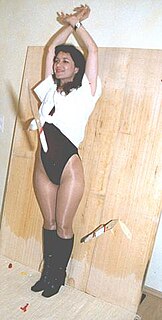
In circus and vaudeville acts, a target girl is a female assistant in "impalement" acts such as knife throwing, archery or sharpshooting. The assistant stands in front of a target board or is strapped to a moving board and the impalement artist throws knives or shoots projectiles so as to hit the board and miss the assistant. The image or character of the target girl has become an icon in fiction and visual media.
Wheel of death may refer to:

The Drill of Death is a large-scale stage illusion in which a performer appears to be impaled on a giant drill. It was created by magician André Kole and illusion designer Ken Whitaker for magician Melinda Saxe. It was one of Saxe's signature tricks and featured as a highlight in her various First Lady of Magic shows.

The Wheel of Death, in the context of acrobatic circus arts, is a large rotating apparatus on which performers carry out synchronized acrobatic skills. The "wheel" is actually a large space frame beam with hooped tracks at either end, within which the performers can stand. As the performers run around on either the inside or outside of the hoops, the whole apparatus rotates. Performers also perform balancing skills with the wheel in a stationary position.
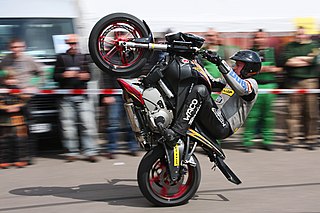
In vehicle acrobatics, a wheelie, or wheelstand, is a vehicle maneuver in which the front wheel or wheels come off the ground due to sufficient torque being applied to the rear wheel or wheels, or rider motion relative to the vehicle. Wheelies are usually associated with bicycles and motorcycles, but can be done with other vehicles such as cars, especially in drag racing and tractor pulling.

The Cyr wheel is an acrobatic apparatus that consists of a single large ring made of aluminum or steel with a diameter approximately 10 to 15 cm taller than the performer. The performer stands inside the Cyr wheel and grasps its rim, causing it to roll and spin gyroscopically while performing acrobatic moves in and around the rotating wheel. The apparatus and its movement vocabulary have some similarities with the German wheel, but whereas the German wheel consists of two large rings linked together by horizontal crossbars and has handles for the performer to hold onto, the modern Cyr wheel consists of a single ring and has no handles. The Cyr wheel takes its name from Daniel Cyr, who revived its popularity, utilising it as a circus apparatus at the end of the 20th century.
Modern competitive archery involves shooting arrows at a target for accuracy and precision from a set distance or distances. This is the most popular form of competitive archery worldwide and is called target archery. A form particularly popular in Europe, North America, and South America is field archery, shot at targets generally set at various distances in a wooded setting. There are also several other lesser-known and historical forms, as well as archery novelty games.

A Devil's wheel, Teufelsrad, Human Roulette Wheel or Joy Wheel is an amusement ride at public festivals and fairs. Devil's wheels have been used at Oktoberfest celebrations since at least 1910.
References
- ↑ Stan Brion, "Foreword", in Adamovich, Heil & Schollenberger, A Day on Broadway: The art of being a knife thrower's assistant, Turnshare (London, 2005), ISBN 1-903343-73-9, p.ix
- ↑ "Quotes and stories about Knife Throwers in the Circus". David Adamovich. Retrieved 2007-03-22.
- ↑ "Theatre: Jungle to Garden". Time Magazine. 18 April 1938. Archived from the original on September 30, 2007. Retrieved 2007-03-22.
- ↑ "Wheel of Death Made Deadlier". Archived from the original on 2010-10-11. Retrieved 2010-10-11.